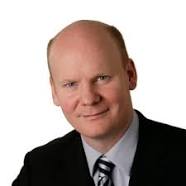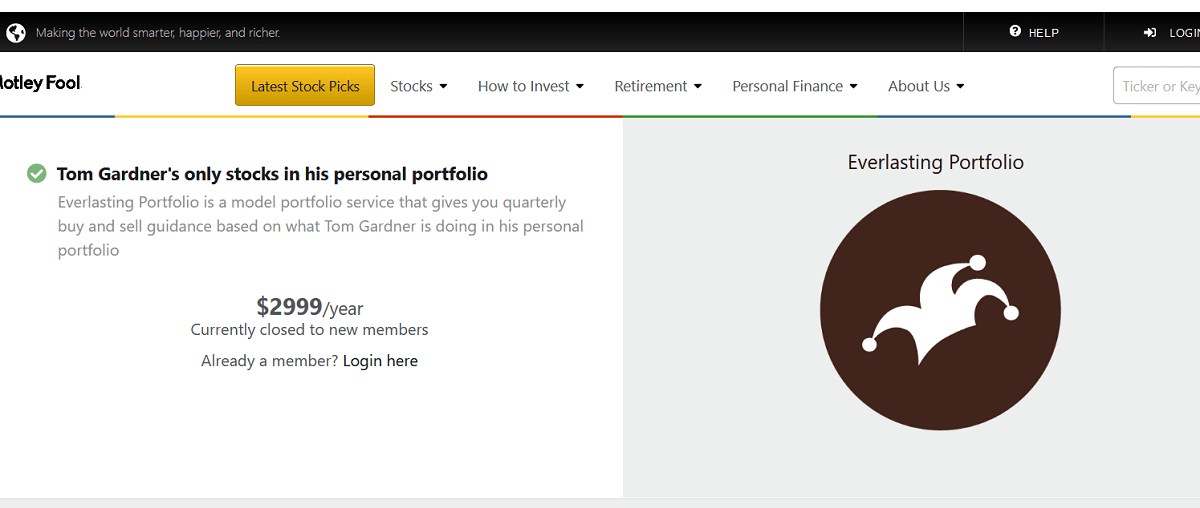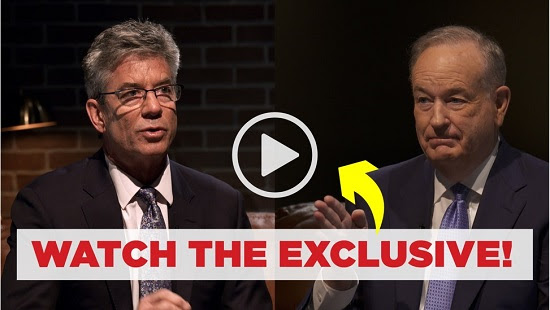How does the Everlasting Portfolio work? Tom Gardner created the Everlasting Portfolio to help Fool One members learn how to generate extraordinary returns.
Table of Contents
- 1 How does the Everlasting Portfolio work?
- 2 How soon after the Everlasting Portfolio picks come out do The Motley Fool and Tom Gardner make their purchases?
- 3 Will the Everlasting Portfolio reach a point where it’s fully built out?
- 4 While I wait for more Everlasting Portfolio picks, what should I do with my cash?
- 5 What should my percentage allocations be to the Everlasting Portfolio?
- 6 Will Tom ever sell a stock from the Everlasting Portfolio?
- 7 What is the Everlasting Portfolio and what separates it from The Motley Fool’s other real-money portfolios?
- 8 What’s the difference between the Everlasting Portfolio and Motley Fool Wealth Management’s Everlasting SMA strategy?
- 9 Who is Tom Gardner?
- 10 MOTLEY FOOL STOCK ADVISOR – Real Users Reviews
How does the Everlasting Portfolio work?
Tom Gardner created the Everlasting Portfolio to help Fool One members learn how to generate extraordinary returns from ultra-long-term investing. Here are some of the basics. The philosophy of the EP is based on the success not only of The Motley Fool, but of greats such as Warren Buffett, who said, “The best time to sell a stock is never,” and Shelby Davis, who practiced that principle for four decades and turned $50,000 into $900 million.
The EP operates on a set investment schedule. The Motley Fool will deposit $100,000 into the portfolio every quarter (on January 1, April 1, July 1, and October 1, or the first subsequent business day). I will then personally make the calls on the five companies we’ll buy, investing $20,000 into each of them.
Stocks may be re-recommended over time; for example, a stock originally purchased in April may very well be purchased again in July.
The portfolio will reinvest all dividends.
Tom will personally be buying all of these stocks — and only these stocks — in his own portfolio.
All EP stocks must be held for a minimum five years from the time they first enter the EP. If a stock has been purchased multiple times for the portfolio, each batch of shares must independently be held for at least five years before that batch can be sold. Once a stock has been held for five years, it can be sold on the same quarterly transaction schedule on which buys are made. When a stock is sold, the resulting cash will be immediately reinvested on that same quarterly transaction day.
With the extra cash, Tom may decide to either spread the cash among the five stocks or allocate the investment among more than five stocks that quarter.
The Everlasting Portfolio will remain fully invested all at times. There is no maximum number of positions and no formal diversification requirements.
All portfolio decisions will be communicated to members in an Everlasting Portfolio report published on the same quarterly schedule outlined above (on January 1, April 1, July 1, and October 1, or the first subsequent business day). Because the portfolio is an educational platform for the Fool One community, we may also offer lessons drawn from the Everlasting Portfolio outside of the quarterly report. As the strategy for the Everlasting Portfolio is ultra-long term buy-and-hold, the team does not offer active coverage or guidance on portfolio positions. We are only interested in following our companies in the hope we can find future additional attractive entry points in the future. Finally, again, every Everlasting recommendation will be made to our Fool One members first. After 24 hours, The Motley Fool will purchase shares. For my personal trades in these stocks, Fool compliance rules require that I not publicly discuss the stocks I’m trading 48 hours before or after I place my personal trades. Many people have questions and want to talk about the new stocks, so I wait three business days after each Everlasting report, then go silent for the required five business days. So, you have three days to ask me any burning questions, and then I must hush up until about another week has passed.
How soon after the Everlasting Portfolio picks come out do The Motley Fool and Tom Gardner make their purchases?
It’s our policy to make sure YOU get into the stocks before we do. That’s why The Motley Fool aims to make its real-money purchase of each round of Everlasting Portfolio stocks one day after the recommendations are released to members.
Shortly thereafter (within the next 30 days), Tom Gardner will make his personal purchases. However, he must be in compliance with our internal trading restrictions, which can delay his purchases (or, likewise, the window in which he can communicate about his stock picks to you).
Will the Everlasting Portfolio reach a point where it’s fully built out?
Every year, we’ll have a maximum of 25 new companies a year entering the Everlasting Portfolio — that’s five per quarter, plus a wildcard round. Based on that, here’s what Tom Gardner says about how big he expects the EP to get:
“You can already see that I have a bias toward adding to existing positions. I first started thinking this way when I read Peter Lynch. He tracked his long-term winners and how his returns would have been hurt had he not continued to follow and add to his winners. The best example for this in our markets today is Starbucks, a company we all know well. It has returned 25% per year since 1992. Buying once and not adding to it = a blunder.
“Over time, I would expect the 25 new investments each year to include an increasing number of adds to existing positions. Warren Buffett’s five largest investments have been held by him for an average of 20 years. That would include holding them through two 40%+ drops in the overall markets. This is Everlasting investing. Downturns are a natural part of the process. We will hold and add money right through them.
“We will definitely get passed 50 stocks. Likely to 75. Then I would expect to see a fair amount of grooving, where I am adding to existing holdings, selling portions of existing positions that I don’t like as much, et cetera. I wouldn’t be surprised to see the portfolio remain at 75 stocks forever. I’ll admit, though, that I’m struggling a bit with it (a high class problem, eh). I love that Shelby Davis got to 1000 stocks. It sends such a great message to the easily anxious average private investor, transacting far too frequently … rather than just using investment to have fun, to profit greatly, and to learn endless amounts about the world.”
While I wait for more Everlasting Portfolio picks, what should I do with my cash?
Once you’ve bought the last five Everlasting Portfolio picks, one strategy is to incorporate stocks from other services with your remaining capital, then slowly transitioning over to EP picks each quarter.
As you’re considering incorporating stocks from outside the EP as you wait for each quarterly round of EP picks, here are some guidelines:
- Use other Foolish services to help fill out the balance of your portfolio. Each service has new recommendations, Best Buys Now, and/or Buy First stocks you can focus on.
- Motley Fool Financial Planning has a tool that can make sure your capital is diversified and widely allocated among Fool recommendations.
- You can also incorporate Fool One’s exclusive Top Recs and Best of the Best Buys Now Report to identify our advisors’ best ideas around the Fool.
What should my percentage allocations be to the Everlasting Portfolio?
Fool One is investing an equal allocation of $20,000 into each stock Tom Gardner picks for the Everlasting Portfolio each quarter. Because the portfolio is still in its early days, with $100,000 added each quarter, our original allocations for each stock will shrink over time as the portfolio grows (all things being equal).
But when it comes to your own portfolio, here are some rough allocation guidelines. Most important, we recommend that you take your time and don’t rush into any investing decisions until you feel comfortable.
- We recommend you don’t aggressively invest all of your capital right away. Spreading it out over six to 18 months is less risky.
- Determine whether you want the EP to represent your entire equity portfolio or just one portion.
- If you’re only investing in the EP, it might make sense to invest a 2% to 3% allocation to each position, increased to up to 5% for multi-recommendations.
- If you are combining stocks from the various Foolish services with the EP, you could decrease your positions to 1% to 2%.
- If you’re only investing in EP stocks, but don’t feel comfortable holding too much cash, you can allocate about 2% per stock and add some various other Foolish service picks with the intention that eventually those positions would be converted into future EP holdings.
Feel free to adjust this framework in situations where Tom builds out a large position, such as he has with LinkedIn. In this case, consider expanding slightly beyond 3% to 5%. If you feel less comfortable about one of Tom’s picks, you can steer closer to 1% or wait until you learn more about the comopany.
We wouldn’t worry too much about exact allocations because it will change over time as stocks move and new money is added. You can always rebalance at a future date if your allocations get out of whack.
— RECOMMENDED —
Alex Green just dropped this BOMBSHELL in brand new O’Reilly interview
He makes a BOMBSHELL prediction about how investors will perform through the first half of the Joe Biden Presidency.
O’Reilly was blown away. I have no doubt you will be too.
Will Tom ever sell a stock from the Everlasting Portfolio?
In his Everlasting Portfolio, Tom Gardner is committed to holding each investment for a minimum of FIVE years. Some folks think this is crazy, but for Tom, it makes complete sense. Making this commitment allows his team and our members to focus on identifying great, sustainable businesses for the long term. Picking and choosing when the “right” time to sell is often a waste of time and energy that could be used to identify great businesses. As Warren Buffett famously said: “The best time to sell a stock is… never.” If we’ve done our job identifying great businesses that make for excellent long-term investments, we won’t have to worry about selling for a very long time.
Here’s what Tom says about the mandatory five-year holding period:
“First, the greatest effect of the rule is that it focuses our attention to companies, strategies, people and away from stock prices, news, and 90-day earnings announcements. I believe what we will lose by not being able to sell out of a position in less than 60 months will be significantly outdone by the value we gain from being exclusively focused on long-term business performance.
“Second, by holding positions, we are forced to learn the lessons. The moment we sell a loser, it becomes so much easier to forget the experience. The faster you sell, I’m convinced, the less you learn. Learning is the primary driver to superior long-term investment results. So I like to position us all to learn the maximal amount, suffer the short-term consequences of some unsellable losers, and vastly improve our long-term investment results in the process.
“The third point goes without saying. Every member can choose to pull out of any Everlasting investment. No need to replicate my approach exactly. I will note that in our first 16 months, both Zillow and Baidu were losers at one point. Zillow looked a little shaky. And Baidu was being held down by accounting concerns across Chinese listed companies. I can’t imagine I would have sold either, were this rule to not exist. But I would have had to consider it. My observation is that active selling for fundamental business investors taxes the mind and nerves. So, this is lower the blood pressure approach.”
What is the Everlasting Portfolio and what separates it from The Motley Fool’s other real-money portfolios?
Tthe Everlasting Portfolio represents Tom Gradner’s investment approach — and it is the portfolio that reflects the holdings that Tom has in his personal account — so he doen’t own any stocks outside the Everlasting Portfolio.
The Everlasting Portfolio is a growth-oriented portfolio with a couple of mandates. One of them is that they do not sell stocks within five years, and that’s because they don’t really think of them as stocks. They think of them as stakes in businesses. So there’s definitely an ownership mentality and that means secondarily they really like to know that there’s ownership mindset in the executive ranks. They want to know that the team that is running that company has a long-term stake in the success. It’s isn’t just there for a couple of years trying to hit their bonus numbers.
What’s the difference between the Everlasting Portfolio and Motley Fool Wealth Management’s Everlasting SMA strategy?
The difference between Motley Fool’s Everlasting Portfolio and the Everlasting strategy they manage in Wealth Management is that in Wealth Management they have professional portfolio managers, there, who are building that portfolio for you and managing very difficult decisions that don’t happen if you think about the Motley Fool’s Everlasting Portfolio.
The Everlasting Portfolio is getting regular cash flows all the time. Are those cash flows matching your cash flows, because that’s a critical distinction. If you think about when you get cash flows in, you want to buy something fairly easy to do, but what if you need cash? If you need cash, what do you sell? Or if there’s a stock you want to buy and your portfolio is fully invested, what do you sell to raise that capital? Those are the types of decisions that their portfolio managers are handling for you on a day-to-day basis.
The Motley Fool ONE Everlasting Portfolio has a rule that it can’t sell a stock inside of five years. The Everlasting SMA is not subject to that restriction, so we are constantly looking and incorporating new information about how a company’s culture, or outlook, or management team might be changing, and they’re allocating that capital based on their best ideas at that moment.
Who is Tom Gardner?

A frequently sought-after investment expert, commentator, and educator, Tom Gardner co-founded The Motley Fool in 1993 with his brother, David, and now serves as Chief Executive Officer. Tom is the chairman of the market-beating Motley Fool Hidden Gems small-cap investment service and co-advisor with his brother of the market-thumping general equity service, Motley Fool Stock Advisor. He and David have co-authored several New York Times best-selling books, including The Motley Fool Investment Guide, You Have More Than You Think: The Motley Fool Guide to Investing What You Have, The Motley Fool Investment Workbook, and most recently, Million Dollar Portfolio: How to Build and Grow a Panic-Proof Investment Portfolio. Tom has testified on behalf of individual investors before the U.S. Senate, calling for greater transparency in the financial services industry. Tom graduated with an honor’s degree in English from Brown University in 1990.
MOTLEY FOOL STOCK ADVISOR – Real Users Reviews
“I’ve been a subscriber to Stock Advisor for 4 years now. I trust their research, and they’ve given me some great ideas (MELI, ATVI, CRM, amongst others). I always follow up with my own research before investing though, as everyone should. The only ding for me is their incessant e-mail marketing.” – Scott Freeman
“I’ve been trying out a few “experts” and recently checked my Motley Fool track record from email alerts I’ve received this past year and I have to say I wish I went with the Motley Fool recommendations instead of the others. 30 of 32 stocks pitched via “buy now” alerts and scorecard emails would’ve made me money. Of course that would depend on when I bought and sold as in any case. I’m still searching and testing but Motley Fool has my vote of confidence right now. FYI, I’m no expert, just a rookie getting up in age with little time left in life to figure it all out myself.” – xyz123
“I’ve followed the Foll since nearly its inception and always been impressed with the quality of the analysis across their reports. I’ve been a Stock Advisor and Rule Breakers client for the past few years, finally giving them something ($$$) back for all the education they provided me through the years.
I would never buy ALL of their recommendations — one of their top rules is “buy what you know” — but their analysis allows me to understand certain companies better and make knowledgeable decisions.
Bottom Line: the stocks I’ve followed their recommendations on have provided an average 125% increase over the past 2 years. I cannot complain about that — The investment gain would pay for the next 15 years of the subscription price.” – Michael Hoffman
Source: StockGumShoe


